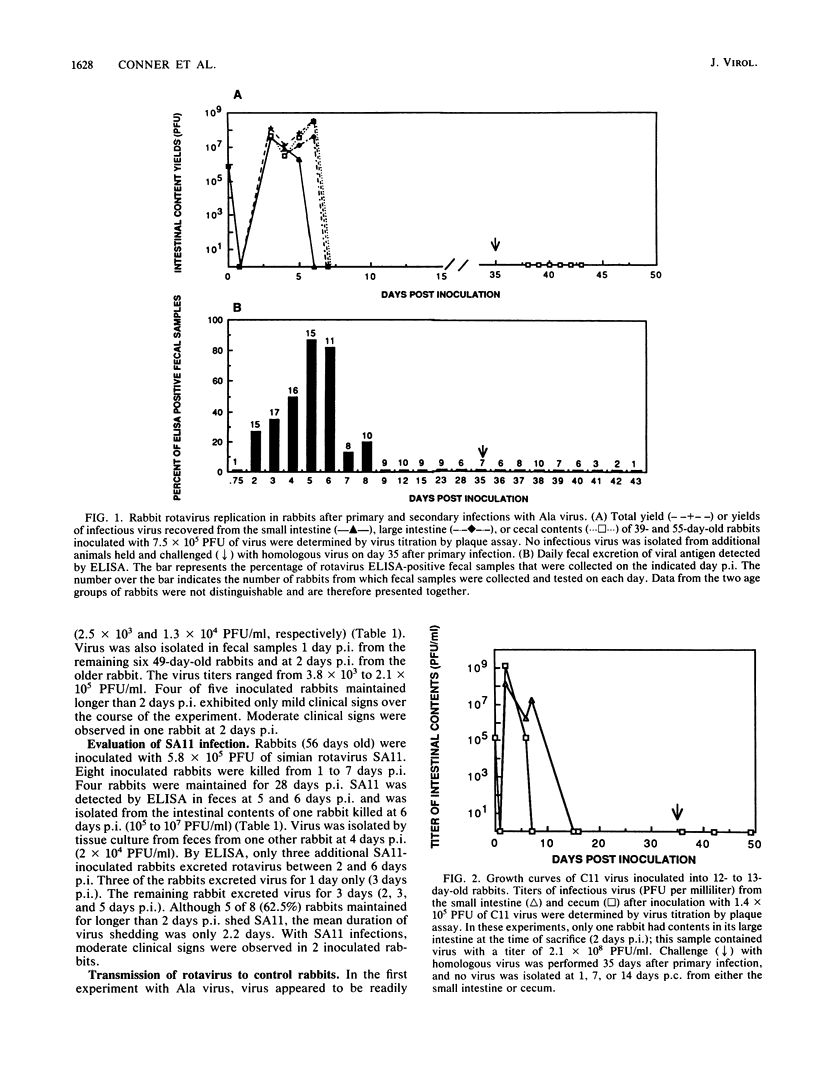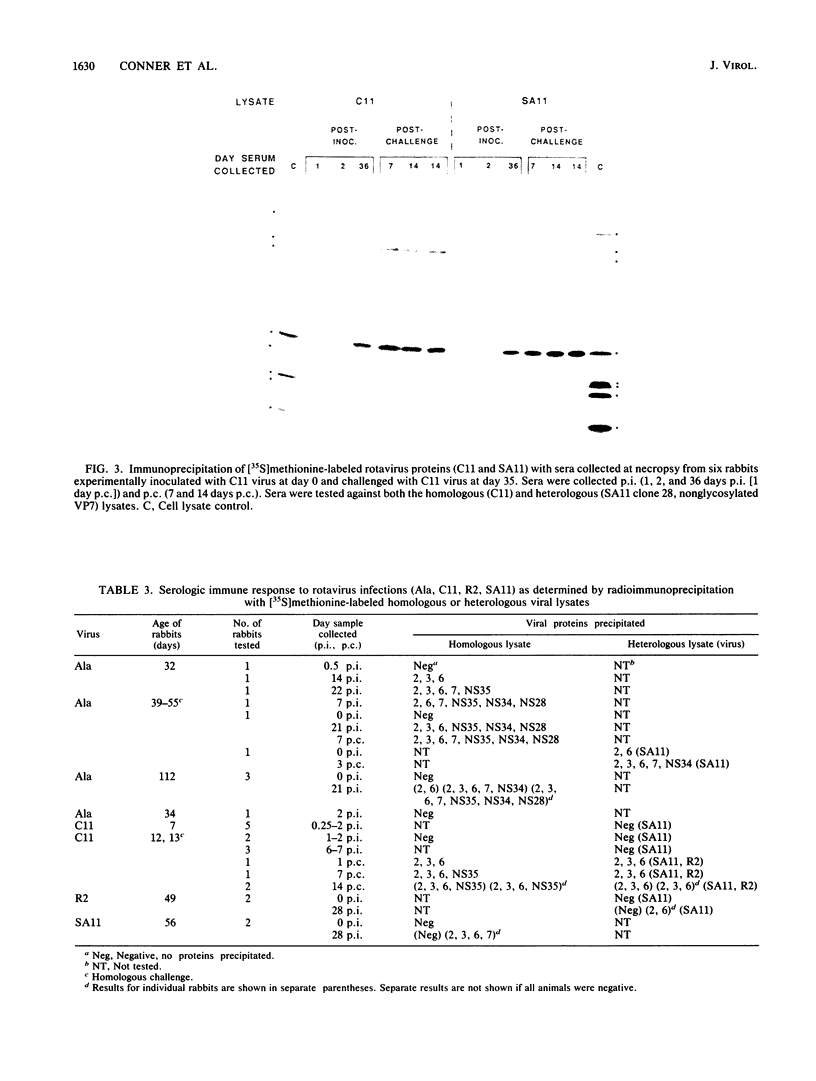Abstract
A new small animal model was developed to study parameters of rotavirus infections, including the active immune response. Seronegative New Zealand White rabbits (neonatal to 4 months old) were inoculated orally with cultivatable rabbit rotavirus strains Ala, C11, and R2 and with the heterologous simian strain SA11. The course of infection was evaluated by clinical findings, virus isolation (plaque assay and enzyme-linked immunosorbent assay), and serologic response. All four strains of virus were capable of infecting rabbits as determined by isolation of infectious virus from intestinal contents or fecal samples, by seroconversion, or by a combination of these methods. The responses differed depending on the virus strain used for inoculation. Rabbits remained susceptible to primary infection to at least 16 weeks of age (upper limit examined). Virus excretion in intestinal contents was detected from 6 h to 7 days postinoculation. RNA electropherotypes of inocula and viruses isolated from rabbits were the same in all samples tested. Transmission of Ala virus and R2 virus but not SA11 virus from inoculated animals to uninoculated controls also occurred. In a challenge experiment with Ala virus, 74- and 90-day-old rabbits were rechallenged with Ala 5 weeks after a primary infection with Ala. Virus was excreted in feces from 2 to 8 days after the primary infection but was not excreted after challenge. These results indicate that the rabbit provides an ideal model to investigate both the primary and secondary active immune responses to rotavirus infections and to evaluate candidate vaccines.
Full text
PDF








Images in this article
Selected References
These references are in PubMed. This may not be the complete list of references from this article.
- Bryden A. S., Thouless M. E., Flewett T. H. Rotavirus and rabbits. Vet Rec. 1976 Oct 16;99(16):323–323. doi: 10.1136/vr.99.16.323-a. [DOI] [PubMed] [Google Scholar]
- Castrucci G., Ferrari M., Frigeri F., Cilli V., Perucca L., Donelli G. Isolation and characterization of cytopathic strains of rotavirus from rabbits. Brief report. Arch Virol. 1985;83(1-2):99–104. doi: 10.1007/BF01310967. [DOI] [PubMed] [Google Scholar]
- Chiba S., Yokoyama T., Nakata S., Morita Y., Urasawa T., Taniguchi K., Urasawa S., Nakao T. Protective effect of naturally acquired homotypic and heterotypic rotavirus antibodies. Lancet. 1986 Aug 23;2(8504):417–421. doi: 10.1016/s0140-6736(86)92133-1. [DOI] [PubMed] [Google Scholar]
- Clark H. F., Dolan K. T., Horton-Slight P., Palmer J., Plotkin S. A. Diverse serologic response to rotavirus infection of infants in a single epidemic. Pediatr Infect Dis. 1985 Nov-Dec;4(6):626–631. doi: 10.1097/00006454-198511000-00006. [DOI] [PubMed] [Google Scholar]
- Clark H. F., Furukawa T., Bell L. M., Offit P. A., Perrella P. A., Plotkin S. A. Immune response of infants and children to low-passage bovine rotavirus (strain WC3). Am J Dis Child. 1986 Apr;140(4):350–356. doi: 10.1001/archpedi.1986.02140180084030. [DOI] [PubMed] [Google Scholar]
- Davidson G. P., Hogg R. J., Kirubakaran C. P. Serum and intestinal immune response to rotavirus enteritis in children. Infect Immun. 1983 May;40(2):447–452. doi: 10.1128/iai.40.2.447-452.1983. [DOI] [PMC free article] [PubMed] [Google Scholar]
- De Mol P., Zissis G., Butzler J. P., Mutwewingabo A., André F. E. Failure of live, attenuated oral rotavirus vaccine. Lancet. 1986 Jul 12;2(8498):108–108. doi: 10.1016/s0140-6736(86)91643-0. [DOI] [PubMed] [Google Scholar]
- Delem A., Vesikari T. Detection of serum antibody responses to RIT 4237 rotavirus vaccine by ELISA and neutralization assays. J Med Virol. 1987 Mar;21(3):231–238. doi: 10.1002/jmv.1890210306. [DOI] [PubMed] [Google Scholar]
- DiGiacomo R. F., Thouless M. E. Age-related antibodies to rotavirus in New Zealand rabbits. J Clin Microbiol. 1984 May;19(5):710–711. doi: 10.1128/jcm.19.5.710-711.1984. [DOI] [PMC free article] [PubMed] [Google Scholar]
- DiGiacomo R. F., Thouless M. E. Epidemiology of naturally occurring rotavirus infection in rabbits. Lab Anim Sci. 1986 Apr;36(2):153–156. [PubMed] [Google Scholar]
- Ericson B. L., Graham D. Y., Mason B. B., Estes M. K. Identification, synthesis, and modifications of simian rotavirus SA11 polypeptides in infected cells. J Virol. 1982 Jun;42(3):825–839. doi: 10.1128/jvi.42.3.825-839.1982. [DOI] [PMC free article] [PubMed] [Google Scholar]
- Estes M. K., Graham D. Y. Identification of rotaviruses of different origins by the plaque-reduction test. Am J Vet Res. 1980 Jan;41(1):151–152. [PubMed] [Google Scholar]
- Evans D. G., de la Cabada F. J., Evans D. J., Jr Correlation between intestinal immune response to colonization factor antigen/I and acquired resistance to enterotoxigenic Escherichia coli diarrhea in an adult rabbit model. Eur J Clin Microbiol. 1982 Jun;1(3):178–185. doi: 10.1007/BF02019620. [DOI] [PubMed] [Google Scholar]
- Eydelloth R. S., Vonderfecht S. L., Sheridan J. F., Enders L. D., Yolken R. H. Kinetics of viral replication and local and systemic immune responses in experimental rotavirus infection. J Virol. 1984 Jun;50(3):947–950. doi: 10.1128/jvi.50.3.947-950.1984. [DOI] [PMC free article] [PubMed] [Google Scholar]
- Gombold J. L., Ramig R. F. Analysis of reassortment of genome segments in mice mixedly infected with rotaviruses SA11 and RRV. J Virol. 1986 Jan;57(1):110–116. doi: 10.1128/jvi.57.1.110-116.1986. [DOI] [PMC free article] [PubMed] [Google Scholar]
- Greenberg H. B., Vo P. T., Jones R. Cultivation and characterization of three strains of murine rotavirus. J Virol. 1986 Feb;57(2):585–590. doi: 10.1128/jvi.57.2.585-590.1986. [DOI] [PMC free article] [PubMed] [Google Scholar]
- Hanlon P., Hanlon L., Marsh V., Byass P., Shenton F., Hassan-King M., Jobe O., Sillah H., Hayes R., M'Boge B. H. Trial of an attenuated bovine rotavirus vaccine (RIT 4237) in Gambian infants. Lancet. 1987 Jun 13;1(8546):1342–1345. doi: 10.1016/s0140-6736(87)90649-0. [DOI] [PubMed] [Google Scholar]
- Nakata S., Estes M. K., Graham D. Y., Loosle R., Tao H., Wang S. H., Saif L. J., Melnick J. L. Antigenic characterization and ELISA detection of adult diarrhea rotaviruses. J Infect Dis. 1986 Sep;154(3):448–455. doi: 10.1093/infdis/154.3.448. [DOI] [PubMed] [Google Scholar]
- Offit P. A., Blavat G., Greenberg H. B., Clark H. F. Molecular basis of rotavirus virulence: role of gene segment 4. J Virol. 1986 Jan;57(1):46–49. doi: 10.1128/jvi.57.1.46-49.1986. [DOI] [PMC free article] [PubMed] [Google Scholar]
- Offit P. A., Clark H. F., Kornstein M. J., Plotkin S. A. A murine model for oral infection with a primate rotavirus (simian SA11). J Virol. 1984 Jul;51(1):233–236. doi: 10.1128/jvi.51.1.233-236.1984. [DOI] [PMC free article] [PubMed] [Google Scholar]
- Offit P. A., Clark H. F. Protection against rotavirus-induced gastroenteritis in a murine model by passively acquired gastrointestinal but not circulating antibodies. J Virol. 1985 Apr;54(1):58–64. doi: 10.1128/jvi.54.1.58-64.1985. [DOI] [PMC free article] [PubMed] [Google Scholar]
- Offit P. A., Shaw R. D., Greenberg H. B. Passive protection against rotavirus-induced diarrhea by monoclonal antibodies to surface proteins vp3 and vp7. J Virol. 1986 May;58(2):700–703. doi: 10.1128/jvi.58.2.700-703.1986. [DOI] [PMC free article] [PubMed] [Google Scholar]
- Petric M., Middleton P. J., Grant C., Tam J. S., Hewitt C. M. Lapine rotavirus: preliminary studies on epizoology and transmission. Can J Comp Med. 1978 Jan;42(1):143–147. [PMC free article] [PubMed] [Google Scholar]
- Saif L. J., Redman D. R., Smith K. L., Theil K. W. Passive immunity to bovine rotavirus in newborn calves fed colostrum supplements from immunized or nonimmunized cows. Infect Immun. 1983 Sep;41(3):1118–1131. doi: 10.1128/iai.41.3.1118-1131.1983. [DOI] [PMC free article] [PubMed] [Google Scholar]
- Sato K., Inaba Y., Miura Y., Tokuhisa S., Matumoto M. Isolation of lapine rotavirus in cell cultures. Brief report. Arch Virol. 1982;71(3):267–271. doi: 10.1007/BF01314878. [DOI] [PubMed] [Google Scholar]
- Schoeb T. R., Casebolt D. B., Walker V. E., Potgieter L. N., Thouless M. E., DiGiacomo R. F. Rotavirus-associated diarrhea in a commercial rabbitry. Lab Anim Sci. 1986 Apr;36(2):149–152. [PubMed] [Google Scholar]
- Snodgrass D. R., Wells P. W. Rotavirus infection in lambs: studies on passive protection. Arch Virol. 1976;52(3):201–205. doi: 10.1007/BF01348017. [DOI] [PubMed] [Google Scholar]
- Starkey W. G., Collins J., Wallis T. S., Clarke G. J., Spencer A. J., Haddon S. J., Osborne M. P., Candy D. C., Stephen J. Kinetics, tissue specificity and pathological changes in murine rotavirus infection of mice. J Gen Virol. 1986 Dec;67(Pt 12):2625–2634. doi: 10.1099/0022-1317-67-12-2625. [DOI] [PubMed] [Google Scholar]
- Steel R. B., Torres-Medina A. Effects of environmental and dietary factors on human rotavirus infection in gnotobiotic piglets. Infect Immun. 1984 Mar;43(3):906–911. doi: 10.1128/iai.43.3.906-911.1984. [DOI] [PMC free article] [PubMed] [Google Scholar]
- Svensson L., Sheshberadaran H., Vene S., Norrby E., Grandien M., Wadell G. Serum antibody responses to individual viral polypeptides in human rotavirus infections. J Gen Virol. 1987 Mar;68(Pt 3):643–651. doi: 10.1099/0022-1317-68-3-643. [DOI] [PubMed] [Google Scholar]
- Thouless M. E., DiGiacomo R. F., Neuman D. S. Isolation of two lapine rotaviruses: characterization of their subgroup, serotype and RNA electropherotypes. Arch Virol. 1986;89(1-4):161–170. doi: 10.1007/BF01309886. [DOI] [PubMed] [Google Scholar]
- Torres A., Ji-Huang L. Diarrheal response of gnotobiotic pigs after fetal infection and neonatal challenge with homologous and heterologous human rotavirus strains. J Virol. 1986 Dec;60(3):1107–1112. doi: 10.1128/jvi.60.3.1107-1112.1986. [DOI] [PMC free article] [PubMed] [Google Scholar]
- Vesikari T., Isolauri E., D'Hondt E., Delem A., André F. E., Zissis G. Protection of infants against rotavirus diarrhoea by RIT 4237 attenuated bovine rotavirus strain vaccine. Lancet. 1984 May 5;1(8384):977–981. doi: 10.1016/s0140-6736(84)92323-7. [DOI] [PubMed] [Google Scholar]
- Vesikari T., Isolauri E., Delem A., d'Hondt E., André F. E., Beards G. M., Flewett T. H. Clinical efficacy of the RIT 4237 live attenuated bovine rotavirus vaccine in infants vaccinated before a rotavirus epidemic. J Pediatr. 1985 Aug;107(2):189–194. doi: 10.1016/s0022-3476(85)80123-2. [DOI] [PubMed] [Google Scholar]
- Vesikari T. Rotavirus infections and their prevention by vaccination. Antiviral Res. 1985;Suppl 1:293–300. doi: 10.1016/s0166-3542(85)80041-3. [DOI] [PubMed] [Google Scholar]
- Vesikari T., Sarkkinen H. K., Mäki M. Quantitative aspects of rotavirus excretion in childhood diarrhoea. Acta Paediatr Scand. 1981 Sep;70(5):717–721. doi: 10.1111/j.1651-2227.1981.tb05774.x. [DOI] [PubMed] [Google Scholar]



